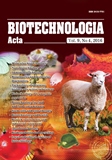ISSN 2410-7751 (Print)
ISSN 2410-776X (Online)

"Biotechnologia Acta" V. 9, No 4, 2016
https://doi.org/10.15407/biotech9.04.077
Р. 77-82, Bibliography 21, English
Universal Decimal Classification: 579.873.71.017.7
ALPHA-AMYLASE PRODUCTION FROM Aspergillus oryzae M BY SUBMERGED FERMENTATION
Zh. B. Suleimenova, Zh. K. Saduyeva, Zh. K. Rakhmetova
Department of Physiology and Biochemistry, Institute of Microbiology and Virology, Almaty, Kazakhstan
The main goal of present study was implementation of the Aspergillus oryzae M strain improved technology using earlier developed method of microorganism selection. 8 pure strains of Aspergillus fungi were screened for the production of extra cellular alpha-amylase using agar medium with starch as a substrate and incubated for 72h at 30 oС. Zone of clearance was observed for screening of the amylolytic fungi (in mm). Aspergillus oryzae M has demonstrated the highest zone of clearance. Aspergillus oryzae M was cultivated for 42 days in submerged conditions of growth using new method of fungal cultivation. This method based on immobilizing enzymes producers on solid career in submerged conditions of growth gives the way to improve quality of filtrates, which remain clear, does not require additional filtering and easily separated from the mycelium. Moreover, it allows to prolong the process of fungal cultivation and to maintain high enzymatic activity for a long period of time. Presented method allowed increasing alpha-amylase production from 321 U/ml (before immobilization) to 502 U/ml (after immobilization).
Key words: α-amylase, Aspergillus oryzae, submerged fermentation, immobilization.
Palladin Institute of Biochemistry of the National Academy of Sciences of Ukraine, 2016
References
1. Rani G., Paresh G., Harapriya M., Vineet K. G., Bhavna C. Microbial a-amylases: a biotechnological perspective. Proc. Biochem. 2013, V. 38, P. 1599?1616. https://doi.org/10.1016/S0032-9592(03)00053-0
2. Lili Kandra. ?-Amylases of medical and industrial importance. Journal of Molecular Structure: Theochem. 2003, N 666, P. 487–498. doi: 10.1016/ j.theochem.2003.08.073.
3. David B. Finkelstein. Improvement of enzyme production in Aspergillus. Antonie van Leeuwenhoek J. Microbiol. 1987, 53 (5), 349?352. https://doi.org/10.1007/BF00400559.
4. Ward O. P., Qin W. M., Dhanjoon J., Ye J., Singh A. Physiology and Biotechnology of Aspergillus. Adv. Appl. Microbiol. 2005, V. 58, P. 1–75. https://doi.org/10.1016/S0065-2164(05)58001-8
5. Vanеk Z., Hosalek Z., Spizek J. Overproduction of microbial products - Facts and ideas. Biotechnol. Adv. 1990, 8 (1), 1?27. https://doi.org/10.1016/0734-9750(90)90003-T.
6. Sidhu G. S., Sharma P., Chakrabarti T., Gupta J. K. Strain improvement for the production of a thermostable ?-amylase. Enzyme and Microbial Technology. 1997, 21 (7), 525–530. https://doi.org/10.1016/S0141-0229(97)00055-0
7. Clark Ford. Improving operating performance of glucoamylase by mutagenesis. Cur. Opin. Biotechnol. 1999, 10 (4), 353–357. https://doi.org/10.1016/S0958-1669(99)80064-0
8. Parekh S. Strain Improvement. Encyclopedia of Microbiology, 3rd edn. 2009, P. 286–298. https://doi.org/10.1016/B978-012373944-5.00169-3
9. Rowlands R. T. Industrial strain improvement: Mutagenesis and random screening procedures. Enz. Microb. Technol. 1984, 6 (1), 3?10. doi: 0.1016/0141-0229(84)90070-X.
10. Vinetsky Y. P., Rozhkov A. M., Sereda A. S., Tsurikova N. V., Nurtayev A. K., Semenov M. V., Zorov I. N., Sinicyn A. P. Increase productivity strain Aspergillus awamori glucoamylase by a combination of radiation mutagenesis and plasmid transformation. Appl. Biochem. Microbiol. 2010, 46 (6), 685?692. https://doi.org/10.1134/S0003683810060128
11. Sanjai Saxena. Strategies of Strain Improvement of Industrial Microbes. Appl. Microbiol. 2015, P. 155?171. doi: 10.1007/978-81-322-2259-0-10.
12. Cohen Y. Biofiltration ? The Treatment of Fluids by Microorganisms Immobilized into the Filter Bedding Material: a review. Biores. Technol. Rev. 2001, V. 77, P. 257?254. https://doi.org/10.1016/S0960-8524(00)00074-2
13. Liu H., Guo L., Liao S., Wang G. Reutilization of immobilized fungus Rhizopus sp. LG04 to reduce toxic chromate. J. Appl. Microbiol. 2012, N 112, P. 651?659. https://doi.org/10.1111/j.1365-2672.2012.05257.x
14. Cai T., Chen L., Ren Q., Cai S., Zhang J. The biodegradation pathway of triethylamine and its biodegradation by immobilized Arthrobacter protophormiae cells. J. Hazard Mater. 2001, V. 186, P. 59. https://doi.org/10.1016/j.jhazmat.2010.10.007
15. Wang L., Ridgway D., Gu T., Moo-Young M. Bioprocessing strategies to improve heterologous protein production in filamentous fungal fermentations. Biotech. Adv. 2005, V. 23, P. 115?129. https://doi.org/10.1016/j.biotechadv.2004.11.001
16. Rhee S. K., Lee G. M., Lee S. T. Influence of a supplementary carbon source on biodegradation of pyridine by freely suspended and immobilized Pimelobacter sp. J. Appl. Microbiol. Biotechnol. 1996, V. 44, P. 816?822. https://doi.org/10.1007/BF00178624
17. Devi S., Sridhar P. Production of cephamycin C in repeated batch operations from immobilized Streptomyces clavuligerus. Proc. Biochem. 2000, V. 36, P. 225?231. https://doi.org/10.1016/S0032-9592(00)00194-1
18. Blieva R. К. An apparatus for the cultivation of microorganisms with filamentous structure. Innovation Patent Кazakhstan № 27164. June 25, 2013.
19. Guisan J. M. Immobilization of Enzymes and Cells (Third Edition). 2013, P. 115?119. https://doi.org/10.1007/978-1-62703-550-7
20. Konstantin A., Lusta K. C., Whan S., Hee S. P., Dong S. Immobilization of fungus Aspergillus sp. by a novel cryogel technique for production of extracellular hydrolytic enzymes. Proc. Biochem. 2000, 35 (10), 1177–1182. https://doi.org/10.1016/S0032-9592(00)00158-8
21. Fiedurek J., Ilczuk Z., Lobarzewski J., Pleszczynska M. Optimization of pectinolytic enzymes biosynthesis by immobilized mycelium of Aspergillus niger 71. Zentralblatt f?r Mikrobiologie. 1992, 147 (1–2), 15?21. https://doi.org/10.1016/S0232-4393(11)80357-4

